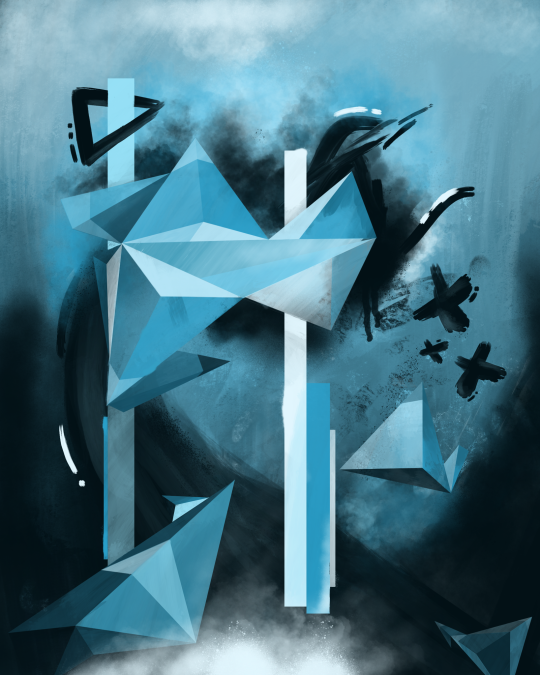Photo
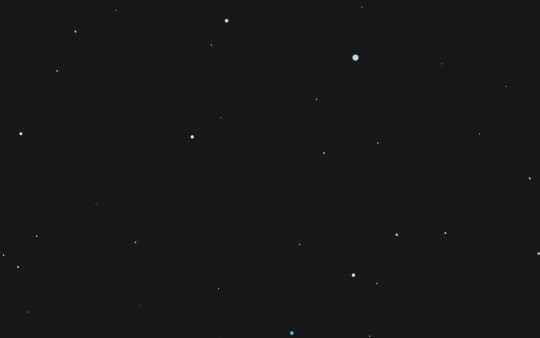
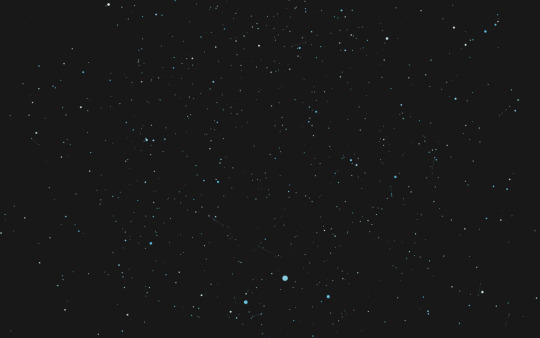

In Free Fall
Follow the link. Use your computer’s arrow keys or WASD to interact. Enter full-screen via the icon.
Best experienced on web browser, full-screen with headphones. Unavailable on mobile/tablet devices.
Work playable on https://groundlessness.io/infreefall
Full thesis text readable on https://groundlessness.io
0 notes
Link
Navigating into the globalized twenty-first century, developing cultural shifts have created a sense of groundlessness for the emerging adult. A philosophical groundlessness. A foundational groundlessness. A developmental and social-relational groundlessness. Semiotics of Groundlessness is a series of anecdotes and research topics, presented as an interconnected constellation to frame these ongoing paradigm shifts of the transition to adulthood in the globalized culture of the twenty-first century.
Reflecting my own discursive practice as an artist and developmental focus as an educator, it is my intent that my research and exposition will be valuable insight for adult readers at the graduate academic level as well as useful framework for adolescent students in the emerging 21st century. The vignettes will expound on interconnected subjects including rites of passage, emerging adulthood, liminality, verticality, referential myths, and virtual horizons, each providing their own valences for their coordinates within the constellation.
Research and references for Semiotics of Groundlessness build on writings and works of Hito Steyerl’s In Free Fall, interweaving them with research of educational psychologist Jeffrey-Jensen Arnett, social anthropologist Victor Turner, as well as post-structuralist writings including Roland Barthes and N. Katherine Hayles. I will be referencing works by contemporary artists such as R. Luke Dubois and Christina Quarles in conjunction with art historical figures of the last two centuries as exemplars of artists working with and setting precedence for the model of groundlessness. Interspersed throughout these coordinates are anecdotal moments from a series of interviews with my former students, all presently between the ages of 18 and 22.
This site originated as a thesis paper in partial fulfillment of requirements for the degree of Master of Fine Arts. Through the drawing of this constellation, my goal is to model a framework, or set of directives, for my own future artistic endeavors as I leave the MFA program at School of the Art Institute of Chicago. In this model, I seek to map the respective coordinates of my own discursive practices and their woven connections within the larger skein.
0 notes
Text
Brendan Getz - The Archipelago
[swimming in the luminous in-between // constellation of ideas]
Is the archipelago the sea or the islands? To navigate past the sunset.
Thule - “beyond any known boundaries” - place beyond boundary, where “the sun goes to rest.”
**names are unstable, names are shifting grounds.
Clarice Lispector: “the name is an accretion that blocks contact with the thing.”
names & languages are spacial barriers, inaccurate
[names as myths // the performance of myth]
“The name is a promise - a sign for a signified.”
Edouard Glissant: “there will be no depth for you, if you underestimate the shore.”
Magicians: “A great illusion isn’t disturbed by knowledge however - it only deepens as a result.”
[Leonardo da Vinci as the Magician]
“A verb… leaves meaning not a name”
-adulting - shifting ‘adult’ from something you are to something you do
[sunset // a perpendicular view]
Photographing the sunset.
Desire. To hold something temporary - loses its luster in any attempt to preserve it.
Blue Hour // Twilight - the bridge between spaces
Desire. Against hopelessness.
Desire. In the in-between.
“But that desire is perhaps all I can offer, which is not actually in any of the words I’ve written, but between them all.”
“The night sky is frozen in a false stillness.”
The embarrassment of having your inner landscapes revealed.
[interstitium] // the between space as an organ in its own right
“In 2007 my grandmother announced to the family she was going to die.”
In control of your own resolution - close to the pulls of death
Sunset
[momentary eternities]
0 notes
Text
Shepherd Defenbaugh - Covers
imitation supplanting the original
Lacan: “The mirror image would involve misrecognition, since the baby knows that the image is not itself. Thus, the mirror stage involves both identification with an image and alienation from it, both recognition and misrecognition.”
“sometimes the simulated, mediated version is easier to understand - easier to see - than the truth.”
Apollo 11 - CBS airing a to-scale simulation alongside grainy footage of the actual landing.
Joseph Kosuth - One and Three Chairs (1965)
Object is secondary. “The art object was dematerialized in such that it no longer was considered the entire artwork, but rather the icon of representation of an artistic intent.”
“There is truth, and there are lies, and art always tells the truth. Even when it’s lying.”
0 notes
Photo

//make contact
//without structure, events feel unreal
//as though context were also kind of an imprisonment
0 notes
Text
I’ve passed the halfway mark, in which I’ve officially lived over half my life going by ‘Luke.
naming through self-regard
names acquired through rites, through passage
through ritual
Daenerys Stormborn of the House Targaryen, First of Her Name, the Unburnt, Queen of the Andals and the First Men, Khaleesi of the Great Grass Sea, Breaker of Chains, and Mother of Dragons
otherwise known as Dany
Malidoma Patrice Somē
name as attached to destiny
what is described
he who will befriend the enemy / to be friends with the enemy
D. Dengenge: stop & listen
(denise) god of wine & pleasure
Theodore Luke Jenner III
Theodore: gift from god
Luke: light
Jenner: engineer/designer
III: (II was an airfare pilot, I owned a gas station in Ohio)
Discord between Mom & Dad
My Dad wanted to connect with a father he never knew
My Mom didn’t care for the names (Theo, Ted, Teddy, etc)
Neither did I as I grew up... fully disconnected from it
TJ were my initials
TJ Jenner didn’t equate tho
Luke fit better. I felt a strong connection to Luke Skywalker.
Agency in choice of own name, of own self-regard
Naming Ritual -> Come out of a ritual with a new, given name
attachment of language to taste
wine: don’t taste things until you read them
is the same for color?
"if we can release ourselves from naming, perception through senses takes precedence.”
Dana DeGiulio: nervous, painting vs art
art: contextual relationships
painting: form, the object
Judy Ledgerwood: stand on its own, without the presence of the artist there
“Shakespeare was a black woman.”
identifying with an artist who isn’t there
the “I” applies to me
0 notes
Text
DIS Case Study
Moving out of the US financial crisis of 2008, DIS art collective was founded by a group of like-minded former workers and freelancers from the culture industry. At the core are four artists - Lauren Boyle, Marco Roso, Solomon Chase, and David Toro – each coming from backgrounds such as advertising, web marketing and market research, fashion for commercial print and television, and product development. Each member’s artistic background stems from their attendance to undergraduate art school from various universities, though they shared similar inclinations of becoming industry-artists based in New York City rather than pursuing a traditional artist career, such as that working via grants or through galleries. Initially starting as a web-based magazine production, DIS has shown installation-based artwork at galleries around the world, including Musée d’Art Moderne de Paris and MoMA’s 30th bi-annual New Photography exhibition. The group has also operated in curatorial roles, such as curating the 9th Berlin Biennale. Falling under a label of “post-internet” art, their work takes the form of installations, videos, and exhibitions which respond to and reflect on 21st century media cultures of consumerism, commercialism, global politics, and generational demographics. Their initial project DIS Magazine, which curated writings and artworks from both collective members and collaborating artists, evolved into several more projects such as DISimages, a parody stock photography website, and DISown, a pop-up retail store and web store which also hosted works by both the collective and collaborators. More recently, in 2018 the collective launched dis.art, a web-based content-streaming service hosting video artworks by once again themselves and collaborators. Throughout the forms their work takes, DIS has modeled a framework for artists to use as a paradoxical and transgressional bridge between commercial and non-commercial modes of production. In this case study, I seek to analyze and evaluate the function and modes of presentation in their works.
Even before their formation as a collective, members of DIS had implicated their practices in conversation with the exclusivity of high-art, or academic gallery and museum circles. Pursuing commercial industry careers after art school, the group shared the viewpoint that an artist bound to grant applications, gallery curators, or the academic, elevated vocabularies of institutions was an oppressive and ingenuine artistic career. (Glazek 2014) Rather, the group took to digital markets for contemporary art, taking inspiration from 21st century designers, brands, and entrepeneurs to derive their own creative undertakings. Directly confronting the 2010s art school politics, the group released their own line of clothing via their DISown platform between 2014-2016. Beginning with their curation of a group exhibition dressed as a pop-up retail shop at Red Bull Studios in New York, the group’s clothing included textual messages such as “NOT FOR EVERYONE” paired with “MADE BY ARTISTS” AND “100% FOR SALE.” (Art observed 2014) Available on the digital market of DISown is their Art School Tracksuit, a hand-painted parody of Adidas’ streetwear described as “brand worship on a budget.” (DIS, Art School Tracksuit n.d.) Other contributing artists to the exhibition contributed clothing items such as a baseball hat equipped with a discreet security camera and beanies made for plant pots displaying digital activist names such as Snowden and Assange. While the work can be interpreted as a critique against commercial and brand culture, it also aims itself at showcasing the paradox of marketing art for the sake of art as a brand. The exclusivity in the statement “NOT FOR EVERYONE” while simultaneously working to attract a multitude of audiences. Rather than critiquing the brand, DIS accepts the brand and encases it into a new context. The initial exhibition was hosted at Red Bull Studios, a brand already seeking to be more of a media network than just their product. DIS does not hide their artwork’s existence in a commercial space, they flaunt it. It becomes a focus in their modeling. Through adopting the visual aesthetics and technical processes of the commercial advertising each member has a history with, their work seeks an appearance that stems from automation and not the hand of an artist. The platforms they created through DISown invited other artists to operate in a space that, while subversive, does not seek to dismantle or operate in opposition to mainstream commercialism and branding, but rather reformat it.
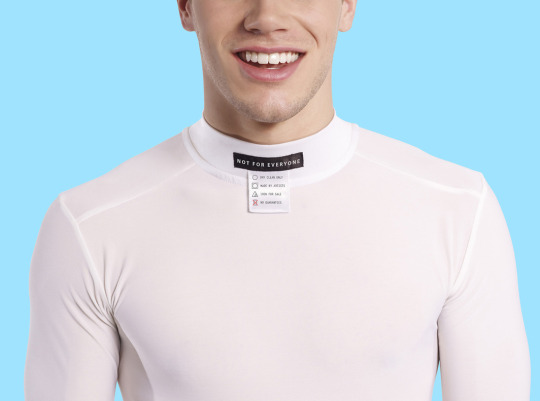
(disOWN at Red Bull Studios, 2014)
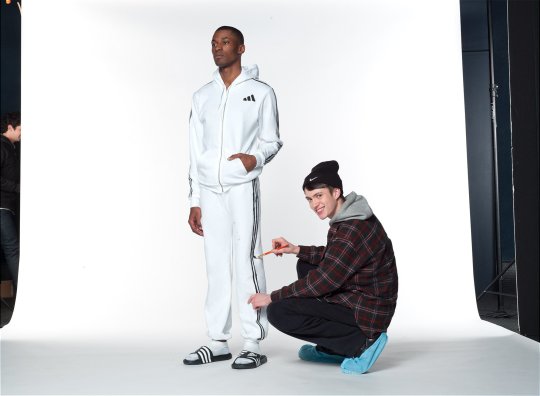
(Art School Track Suit, 2014 via disOWN)
The collective brought this reformatting not just to other artists through their own platforms, but also through wider scale curation. Their work in curating the 9th Berlin Biennale created a brand, or a format, for the exhibition to exist as a larger network than just the artists showing. Evident on the exhibition’s website is a design aesthetic that pulls from the collective’s own visual stylings of commercial advertising. Just as a brand aims to be more than its product, DIS’ brand for the exhibition seeks to be more than the artists and works that were shown. While the biennale itself took place in Berlin, the site cleans itself of any localized content to Berlin as DIS themselves were “trying to manipulate the situation, and give the Berlin Biennale another kind of voice.” (DIS, DIS Placed: Q&A with the Curators of the Berlin Biennale 2016) If art and commercial design are inherently separate, DIS dances in the paradoxical format of art as brand in the 21st century. As with DISown, if their work is subversive or satirical to systematic problems with commercialism, it is not that way through plain parody but through repurposing and reformatting existing systems.
In theme of reformatting existing systems, the group rolled out their 2016 video ‘Public Service Announcements’ via not just gallery showings, but paid-for advertisements on social media networks like Twitter and Instagram. ( (Boyle 2018) One of the PSAs titled A Good Crisis appropriates the Night King, a character from television show Game of Thrones that in its context symbolizes an inevitable climate demise for the story, and re-contextualizes them into a luxurious character explaining systematic exploitations by housing markets during the 2008 economic crash to its audience. The entire piece is quick, utilizing rapid cuts to capture the attention of the social media audience, just as a regular commercial would seek to entertain its audiences. The content, however, comes from what would have otherwise been an activist essay aimed at educating audiences. (Boyle 2018) Combining the two, DIS makes use of the video-essay format that is overtly subversive of the commercial spaces it injects itself into. It’s forward in its satire, as Boyle of the collective claims, it is “100 percent about realizing we’ve been hoodwinked by the system and that capitalism as it’s functioning today does not work for the majority of people.” (Boyle 2018) In their bridge-space between commercial and art, DIS appeals to a multitude of populations for their activist philosophies and causes.

(A Good Crisis, 2016 via dis.art)
Or, that at least appears to be their goal. The framework the collective creates for their art treads in many paradoxical transgressions. Seeking to be educational, yet entertaining. Art, yet commercial brand. Accessible, yet reserving opacity of an artist. Overtly subversive, yet fitting within existing formats. If there’s a line between critiquing a system and contributing to it, DIS operates on both sides of that line, placing their work in a functional flux. DISown, while offering many questions of the branding of the artworld and new formats for academic art, is still a profit-geared store. Dis.art, while educational and artistically insightful, is still a consumer-driven content streaming platform. DIS as a collective have created a transgressive paradox for their own practice.
Bibliography
Art observed. 2014. "DIS: "DISOWN" at Red Bull Studios Through April 6th, 2014." Art Observed. March 13. http://artobserved.com/2014/03/new-york-dis-disown-at-red-bull-studios-through-april-6th-2014/.
Boyle, Lauren, interview by Loney Abrams. 2018. A Good Crisis: DIS' Lauren Boyle Discusses the Art Collective's New Political PSA Videos (October 17).
DIS. n.d. "Art School Tracksuit." disown. https://disown.dismagazine.com/products/art-school-tracksuit.
DIS, interview by Tess Edmonson. 2016. DIS Placed: Q&A with the Curators of the Berlin Biennale (June 1).
Glazek, Christopher. 2014. "Shopkeepers of the World Unite." Artforum. June 12. https://www.artforum.com/slant/christopher-glazek-on-generation-dis-47107.
0 notes
Text
Bunny Rogers Case Study
Born in 1990, New York City based artist Bunny Rogers serves as a case example of a millennial artist reflecting on and re-projecting her own adolescence through her practice. Her work makes use of dozens of cultural references such as cartoon characters, celebrities, and storybooks and places them under the context of real-world tragedy. She threads connections between these through investigations of subcultures and dynamics of adolescent emotional repression in the 21st century. At times opaque through her references, Rogers’ practice creates a two-way road of interaction: audience-to-artist and artist-to-audience. Bunny Rogers uses her own youth as a navigating needle to weave a memorializing skein of media’s projections on 21st century adolescent violence, alienation, and identity.
At its surface level, much of Rogers’ work operates as sculptural installation. Using professional craftsmanship of commercial furniture building, Rogers juxtaposes the pre-fabricated aesthetic with the intimacies of handmade objects. Her State Skool Chairs and Clone State Chairs from 2014 solo exhibition Columbine Library in Berlin are simple fabricated reproductions of chairs from a high school library setting positioned adjacent to one another and furnished with handmade backpacks of fabric and ballet slippers imbued with adolescent pop culture references. From the same 2014 exhibition, Clone State Bookcase is also a wood and metal fabrication of a bookcase, filled with handcrafted plush dolls in lieu of books. Her 2016 solo exhibition Columbine Cafeteria maintains this approach, fabricating cafeteria tables, chairs, and wardrobes to be adorned with handmade articles of clothing. This contrast between the fabricated and the handmade works to show the stark relationships between the cold, sterile aesthetics of mass-produced space and the personal intimacies of youth cultures that Rogers approaches in her work’s conceptual meditations. For her own attention, the customized details of pieces like the dolls or bags get highlighted, revealing a personal dedication and a fixation on the references she connects in the work.

(Clone State Bookcase. Maple wood, metal, Limited-Edition Elliott Smith plush dolls, "Ferdinand the Bull" third-place mourning ribbons, casters. 97 x 121.5 x 24 inches)
For Rogers practice, these references pull from a network of her own interests, hobbies, and personal history. Characters like Gaz Membrane from early 2000s cartoon Invader Zim, Jeanne D’Arc and Mandy Moore of MTV cartoon Clone High from the same time, singer-songwriter Elliott Smith noted for potentially taking his own life via stab wounds in 2003, along with dozens of other small, niche and nuanced references all appear throughout Roger’s works. On approaching her practice, most of these references needed my own research; I’d understood certain references like Invader Zim or allusions to roleplaying game/website Neopets, though I’m fortunately coming from the cultural standpoint of being born just two years after Rogers. Other references I needed to look up and spend more time with beyond a quick web search to gain some background context to Rogers’ referential motifs. (Thoroughly recommend a watch of Clone High.) In her State Skool Bench pieces from Columbine Cafeteria, Rogers depicts reproductions of these characters reading poetry, set on backdrops of Columbine High School from Columbine, Colorado – location of the 1999 school shooting that Rogers uses as a contextual underpinning for the two exhibitions. In using these characters, Rogers caters towards a very selective audience to make the immediate connections, as I was able to, or asks the audience for the contextual research. For the uninitiated, Rogers work is largely veiled in an opacity with the references serving as windows in; she creates multiple openings for the viewer to gain vantage points into the whole body her work explore. From the audience-to-artist perspective, this waypoint of accessibility is relatively particular and at times demanding or discriminatory. Or, from the artist-to-audience perspective, Rogers’ practice is one of seeking connection. She offers up pieces of herself that are from larger popular cultures: her personal interests in television shows, storybooks, and musicians that come from subcultures shared by others from her generation or cultural backgrounds. Under the context of Columbine High School, the work calls for a delicate and sympathetically attentive viewing into the nuances and idiosyncrasies of the artist’s references as common responses to the tragedy claim the perpetrators lacked sympathetic and sincere connections that could have prevented their actions. (Cohen, 2016) Rather than a call-for-help to an outsider, the references can be read similar to a teenager wearing a band t-shirt – as a signal for likeminded people with shared affinities for subcultures and fandoms.

(State Skool Chairs. Wood, grey faux suede, handmade and beaded backpacks, ballet slippers. 28 x 44.5 x 44.5 inches)
The connection to fandoms and subcultures resounds through Rogers’ practice and in some cases constitutes derivations of celebrity worship. The characters she draws to – Gaz and Jeanne - are written as troubled girls, students coping with difficulties expressing themselves and relating to their peers. Both characters internalize aggression and are prone to dramatic outbursts of language, enacting a female violence in reflection to adolescent male violence such as the Columbine Massacre for which the exhibition takes its name. In giving handmade attention to these characters, Rogers embodies the fascination and idolization adolescents, specifically adolescent girls in this case, build with fictional characters. However, in approaching some of the violent facets of these characters, Rogers also draws reference to niche modes of communicating shared feelings. Clone State Bookcase (2014) features the handmade plush dolls of late musician Elliott Smith in a caricature style reminiscent of characters from Neopets. Speaking from my own experience with the website, Neopets was (and still is) a platform for youth-based message boards in which users were able to anonymously connect with one another in the innocent-appearing context of a comic-styled web game. For a developing adolescent, sharing feelings of controversial and troubling matters such as internal aggression and depression becomes much easier under the guise of anonymity. Platforms like Neopets from the early 2000s evolved over the next decade into blog websites such as Tumblr, creating spaces for users to explore morally ambiguous topics. In her practice, Rogers investigates subculture circles on these platforms such as one devoted to a romantic fantasized obsession with Eric Harris and Dylan Klebold, the perpetrators of the Columbine Massacre. (Rogers, 2016) Coming as a post-internet reflection of media’s response to the event fifteen years prior, Rogers explores the outlets that allowed the developing millennial generation to communally work through their internalized struggle with the projected truths of the tragedy.
youtube
Poetry Reading with Gazlene Membrane in Columbine Cafeteria.
For a niche fandom community, being able to speak and express oneself anonymously on an issue otherwise seen as controversial or immoral comes as a rebellious act against repression of emotion. Just as teenage girls’ fanatic response to The Beatles in the mid-20th century can be historically read as enactment of freedom against sexual repression (Cohen 2016), these subcultures Rogers embodies in her practice can be liberating or comforting for an adolescent internalizing media-projected violence without resolution. In her installations, Rogers takes these internalized emotions and materializes them through the enactment of her handmade works. Be it in meticulously repetitive handiwork as in the Elliott Smith plush dolls in Clone State Bookcase or fanatic attention to detail of the bags in Clone State Chairs, Rogers presents this embodied culture as artifact for public examination. In doing so, she creates a bridge between the private lives of the internalizing teen and the public vision of the outsider. The fan art found on Tumblr operates both as expression of emotional empathy for characters by the artist, but also as a call for the like-minded. Rogers’ work also comes as a call for those that get her references and invites them into the shared space of emotional expression.
In these references, Rogers’ strings together a body of work that is deeply personal to her own childhood and adolescence. Rather than looking at the dynamics of subcultural fandom and adolescent angst as object, she uses herself at subject operating inside a model of cultural investigation that becomes the object. Her work isn’t concerned with accessibility of the outsider further than putting it on display; she invites the audience into her own web of history as an exploratory experience. Her personal website doesn’t serve as a clean and ready artist’s portfolio as much as it’s an extension of her own investigations on her self. A now-expired countdown until her “graduation” of the 27 Club, a playful homage to a spider character, and links to her own blog-like Facebook status updates all work as references to developing youth culture as experienced online. (Rogers, Meryn.Ru n.d.) The model she has weaved together takes in the internet-millennial’s response to media projections of tragedy then investigates and re-projects that response into spaces of sensitivity. The internet-millennial here being a third party witness, or residual victim, to these tragedies and acts of violence. Rogers was a child at the time of the Columbine Massacre of which she contextualizes these two exhibitions. She has not visited the site of the shootings nor has addressed personal relationships with victims or their families. (Rogers, Columbine Cafeteria 2016) In this, she holds true to her role as third-party witness and explores the impact on that third party in her practice.
//end of case study
//below are personal reflections
Researching Bunny Rogers’ work came as surprisingly enlightening for my own practice on some facets I’m realizing I’d been getting advised on though that advice had not been connecting. As a teacher, I approached Rogers’ body of work looking for another artist interested in adolescent development in the 21st century. I didn’t expect to find work that was as self-indulgent – looking to her own cosmology as subject rather than focusing on a model as object. This contextualization and re-projection of personal history positions herself as a conduit for cultural reflection. In my own practice, I’ve been interested in researching and building models of similar cultural reflection, though had largely left my own histories as a millennial out of the work. I kept getting asked where I was in my own work, to which I’d usually freeze up and start rambling about my students. My own mark was literally evident in the markmaking of my pieces, which related to a personal history and artistic upbringing in graffiti, though that had become all that was left. I admire Rogers’ methods of using her own self as access into culture rather than just presenting a model to discuss. Her practice embodies much of the facets that interest her. I’m interested in using multi-modal installation as a way to invite viewers to embody experiences and spaces.
Works Cited
Cohen, Sascha. The Columbine Shooters, the Girls Who Love Them, and Me. January 31, 2016. https://www.vice.com/en_us/article/3dx93w/the-columbine-shooters-the-girls-who-love-them-and-me.
Rogers, Bunny. Columbine Cafeteria. Greenspon Gallery, New York City.
—. Columbine Cafeteria. July 26, 2016. http://societeberlin.com/zh/exhibitions/bunny-rogers-columbine-cafeteria/.
Rogers, Bunny. Columbine Library. Societe, Berlin.
1 note
·
View note


